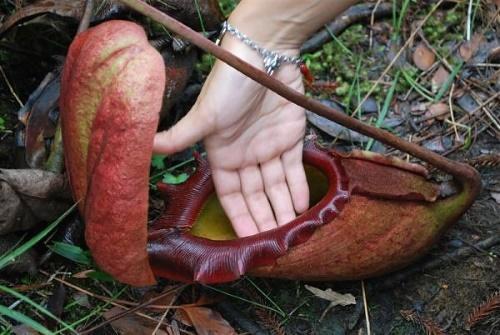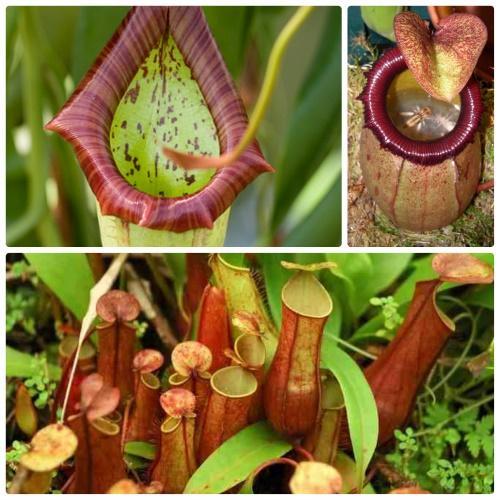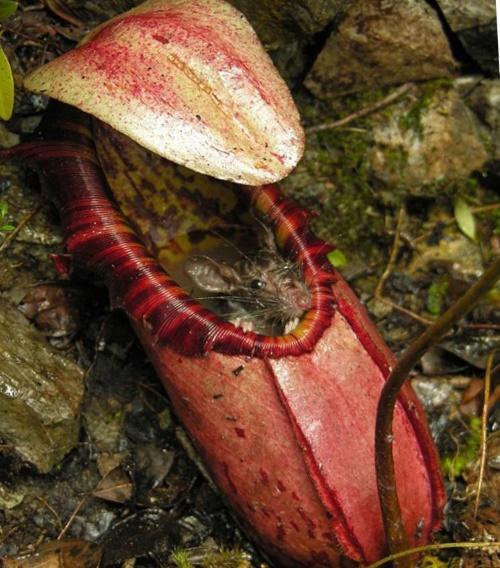The largest carnivorous plant is nepentes raja
 The fashion for collecting outlandish things has always been and will always be. Some collect commemorative coins or stamps, while others prefer exotic plants. We are not talking about tangerines or kiwi on the windowsills, but about real predators. They do not need fertilizers, and live insects serve as food for plant hunters. One of these predators is sundew, which is often grown at home. But you will hardly find the largest carnivorous plant in greenhouses and houses. Nepentes Raja is the name of the carnivorous bush with the largest trap. What does it look like, where does it grow and what does it eat?
The fashion for collecting outlandish things has always been and will always be. Some collect commemorative coins or stamps, while others prefer exotic plants. We are not talking about tangerines or kiwi on the windowsills, but about real predators. They do not need fertilizers, and live insects serve as food for plant hunters. One of these predators is sundew, which is often grown at home. But you will hardly find the largest carnivorous plant in greenhouses and houses. Nepentes Raja is the name of the carnivorous bush with the largest trap. What does it look like, where does it grow and what does it eat?
The largest carnivorous plant is nepentes raja

At first it is small, but over time it acquires an elongated shape, resembling an open jug. The edges of the jug are turned outward. The end of the trap is a kind of cover in the form of a folded hand. The outer surface of the jug is waxy and slippery, the same color as green leaves. Inside, the trap is a deep burgundy red. It is filled with liquid, and the surface of the walls is covered with hairs.
The average height of the trap in most species of nepentes does not exceed 10 cm. But nepentes raja builds up a jug with a diameter of up to 16 cm and a height of 35. No carnivorous plant possesses such traps, which makes the raja the largest of them.
How and what does the nepentes raja eat?
 The edges of the water lily are covered with a kind of sticky nectar, the smell of which attracts prey. Insects or animals, sitting on the rim of the trap, slide and fall inside. Only slippery walls, but also the hairs growing on them, prevent them from getting out. Inside the jug there is up to 2.5 liters of liquid, in which the prey drowns. And the lower part contains digestive enzymes that digest insects.
The edges of the water lily are covered with a kind of sticky nectar, the smell of which attracts prey. Insects or animals, sitting on the rim of the trap, slide and fall inside. Only slippery walls, but also the hairs growing on them, prevent them from getting out. Inside the jug there is up to 2.5 liters of liquid, in which the prey drowns. And the lower part contains digestive enzymes that digest insects.
 Due to the large size of the traps, the diet of nepentes rajas can include:
Due to the large size of the traps, the diet of nepentes rajas can include:
- insects;
- mice;
- rats;
- toads;
- lizards;
- small birds.
Where does nepentes raja grow?
 The climate of the humid jungle or highlands is perfect for the Nepenthes. Madagascar, the southeastern territories of Australia and Asia - this is where these predators grow.But you can find nepentes raja only on the island of Borneo, where it grows on Mount Kinabalu. The plant belongs to endangered species and is protected by international conventions.
The climate of the humid jungle or highlands is perfect for the Nepenthes. Madagascar, the southeastern territories of Australia and Asia - this is where these predators grow.But you can find nepentes raja only on the island of Borneo, where it grows on Mount Kinabalu. The plant belongs to endangered species and is protected by international conventions.